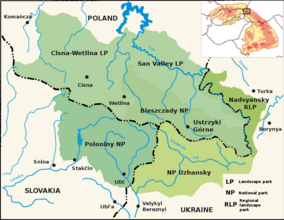UNESCO Biosphere Reserves are environment-protected scientific-research institutions of international status that are created with the intent for conservation in a natural state the most typical natural complexes of biosphere, conducting background ecological monitoring, studying of the surrounding natural environment, its changes under the activity of anthropogenic factors.

A transboundary protected area (TBPA) is an ecological protected area that spans boundaries of more than one country or sub-national entity. Such areas are also known as transfrontier conservation areas (TFCAs) or peace parks.

Bieszczady Mountains is a mountain range that runs from the extreme south-east of Poland and north-east of Slovakia through to western Ukraine. It forms the western part of the Eastern Beskids, and is more generally part of the Outer Eastern Carpathians. The mountain range is situated between the Łupków Pass and the Vyshkovskyi Pass. The highest peak of Bieszczady is Mt Pikui in Ukraine. The highest peak of the Polish part is Tarnica.
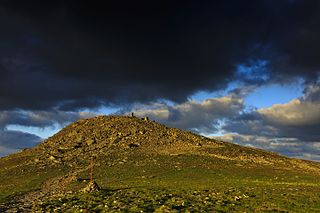
Babia Góra National Park is one of the 23 national parks in Poland, located in the southern part of the country, in Lesser Poland Voivodeship, on the border with Slovakia. Its headquarters are located in Zawoja. A Nature Reserve which roughly covered the area of the modern-day national park was created in 1933, with the actual park established on October 30, 1954. Since 1976, it has been designated by UNESCO as a biosphere reserve.
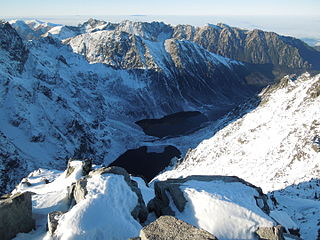
Tatra National Park is a national park located in the Tatra Mountains in Tatra County, in the Lesser Poland Voivodeship in central-southern Poland. The park is headquartered in the town of Zakopane.

Poloniny National Park is a national park in northeastern Slovakia at the Polish and Ukrainian borders, in the Bukovské vrchy mountain range, which belongs to the Eastern Carpathians. It was created on 1 October 1997 with a protected area of 298.05 km2 (115.08 sq mi) and a buffer zone of 109.73 km2 (42.37 sq mi). Selected areas of the park are included into Primeval Beech Forests of the Carpathians UNESCO World Heritage Site.

The European Diploma of Protected Areas, established in 1965, is a diploma awarded by the Council of Europe to protected areas of exceptional European conservational interest. It is awarded for a five-year period at a time and is renewable. Over 60 areas in 23 states have received the award so far.

Tatra(s) National Park is one of the nine national parks in Slovakia. It is situated in North Central Slovakia in the Tatra Mountains. The park is important for protecting a diverse variety of flora and fauna, with many endemic species, including the Tatra chamois.

Protected areas of Poland include the following categories, as defined by the Act on Protection of Nature of 16 April 2004, by the Polish Parliament:

Śnieżnik Landscape Park is a protected area in south-western Poland, established in 1981, and covering an area of 288.00 square kilometres (111.20 sq mi). It is located in the Snieznik Mountains and the Golden Mountains, two shorter mountain ranges in the Eastern Sudetes, along the border with the Czech Republic. It is part of the Krkonoše/Karkonosze Transboundary Biosphere Reserve, mixed mountain and highland system, bearing UNESCO designation.

Wdzydze Landscape Park is a protected area in northern Poland, established in 1983, covering an area of 178.32 square kilometres (68.85 sq mi).
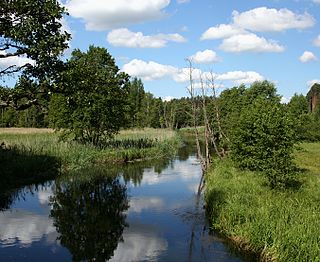
Zaborski Landscape Park is a protected area in northern Poland, established in 1990, covering an area of 340.26 square kilometres (131.38 sq mi) north of the town of Chojnice. It surrounds Tuchola Forest National Park.

Ancient and Primeval Beech Forests of the Carpathians and Other Regions of Europe is a transnational serial nature UNESCO World Heritage Site, encompassing 94 component parts in 18 European countries. Together, the sites protect the largest and least disturbed forests dominated by the beech tree. In many of these stands, these forests here were allowed to proceed without interruption or interference since the last ice age. These sites document the undisturbed postglacial repopulation of the species.
Under UNESCO’s Man and the Biosphere Programme, there are 308 biosphere reserves recognized as part of the World Network of Biosphere Reserves in Europe and North America. These are distributed across 41 countries in the region.

The Krkonoše/Karkonosze Transboundary Biosphere Reserve is a MAB transboundary biosphere reserve, mixed mountain and highland system designated by UNESCO as Krkonoše/Karkonosze Mountains in 1992. It is shared by the Czech Republic and Poland. Notably, it is one of only two successful transboundary management structures in existence, aside from the East Carpathians Biosphere Reserve, due to contrasting goals in other shared areas covered by MAB.

The Roztochia Biosphere Reserve is a UNESCO Biosphere Reserve in Ukraine. Roztochia has a total size of 74,800 hectares (289 sq mi) with its main economic activities including agriculture, stock-breeding and fish farming. The site is located on the north-western edge of the Podillya Upland, 20 kilometres (12 mi) from the city of Lviv, with an area of 30,000 hectares (120 sq mi). The site attracts visitors to its sanatoria and there are plans for developing business and tourism. There is on-going and planned cooperation with Poland in the Roztochia region; in 2019 Roztocze Transboundary Biosphere Reserve, Poland/Ukraine became a designated UNESCO site.

Uzh National Nature Park is a protected area in Ukraine. It is located in Uzhhorod Raion of Zakarpattia Oblast, at the border with Poland and Slovakia. The park was created on 5 August 1999 and has the area of 39,159.3 hectares (151.195 sq mi). Since 2007, it is part of the World Heritage site Primeval Beech Forests of the Carpathians and Other Regions of Europe. It is also part of the East Carpathian Biosphere Reserve. The park was created to protect pristine beech forest of the Carpathians.
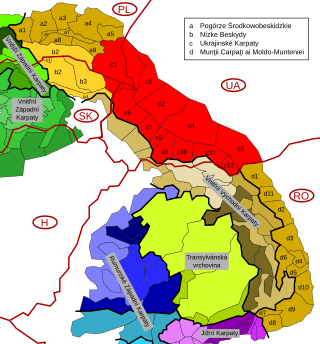
The Eastern Beskids or Eastern Beskyds are a geological group of mountain ranges of the Beskids, within the Outer Eastern Carpathians. As a continuation of the Central Beskids, this mountain range includes the far southeastern corner of Poland, the far eastern corner of Slovakia, and stretches southward through western parts of Ukraine, up to the border of Romania.

The Carpathian montane conifer forests, also known as Carpathian montane forests, is a temperate coniferous forests ecoregion in the Carpathian Mountains of the Czech Republic, Poland, Slovakia, Romania, and Ukraine.

The West Polesie Transboundary Biosphere Reserve is a transboundary nature reserve located in Poland, Ukraine, and Belarus. It is designated as an area of global importance under UNESCO's World Network of Biosphere Reserves under their Programme on Man and the Biosphere.
